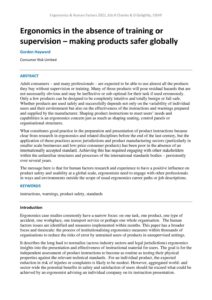| Document | Author Gordon Hayward |
| Abstract Adult consumers – and many professionals – are expected to be able to use almost all the products they buy without supervision or training. Many of those products will pose residual hazards that are not necessarily obvious and may be ineffective or sub-optimal for their task if used erroneously. Only a few products can be designed to be completely intuitive and totally benign or fail-safe. Whether products are used safely and successfully depends not only on the variability of individual users and their environment but also on the effectiveness of the instructions and warnings prepared and supplied by the manufacturer. Shaping product instructions to meet users’ needs and capabilities is an ergonomics concern just as much as shaping seating, control panels or organisational structures. What constitutes good practice in the preparation and presentation of product instructions became clear from research in ergonomics and related disciplines before the end of the last century, but the application of these practices across jurisdictions and product manufacturing sectors (particularly in smaller scale businesses and low-price consumer products) has been poor in the absence of an internationally accepted standard. Achieving this has required engaging with other stakeholders within the unfamiliar structures and processes of the international standards bodies – persistently over several years. The message here is that for human factors research and experience to have a positive influence on product safety and usability at a global scale, ergonomists need to engage with other professionals in ways and environments outside the scope of usual ergonomics career paths or job descriptions. |

